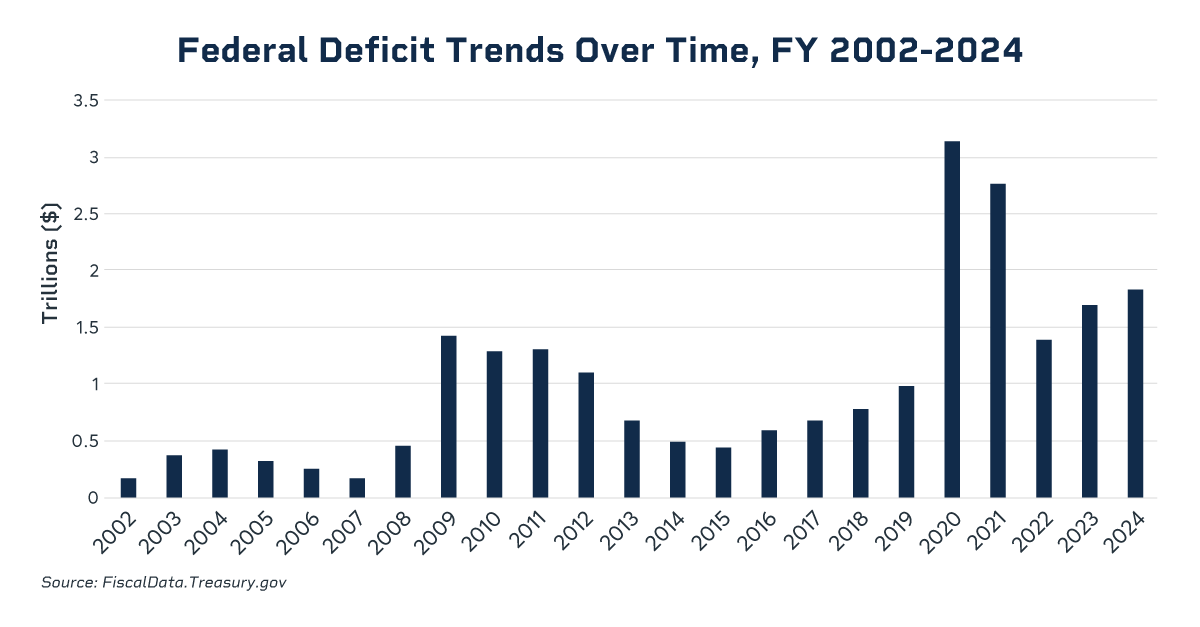Peter Blottman Photography/iStock via Getty Images
By Jim Iuorio
At a Glance
- A weakening U.S. dollar could result in decreased American demand for European goods
- From January to June, the euro experienced a 15% increase against the dollar, climbing from 102 to 117.
The euro’s notable appreciation against the U.S. dollar since the start of 2025 – jumping from 102 in early January to 117 by late June, an almost 15% gain – signals more than typical currency market shifts. This upward movement reflects growing market worries about the U.S. fiscal situation and a reduction in long U.S. dollar positions. Moody’s recent credit rating downgrade, a looming debt ceiling deadline and a weak 20-year auction on May 21 have further underscored these issues. What risk factors result for Europe from the recent surge in the Euro?
Current U.S. Fiscal Landscape
The U.S. federal deficit has more than doubled from $980 billion in 2019 to nearly $1.9 trillion in 2024 and is projected to remain at this level in 2025, with some forecasts suggesting it could reach $2.75 trillion. With the national debt at $36.2 trillion (124% of GDP), there are growing concerns about a potential “debt spiral” fueled by rising debt service costs and yields, potentially leading to increased borrowing at higher rates. Though an immediate bond market crisis is unlikely, the risk is growing.

The lack of progress on reducing the deficit, combined with the possibility of additional spending, deepens concerns about the long-term financial stability of the U.S. This situation risks weakening the dollar and exacerbating global market anxieties.
How Does U.S. Fiscal Stability Impact Europe?
1. Appreciation of the Euro
A persistently strong euro could make European products too expensive for the U.S. market, which could be a problem as the U.S. is one of Europe’s biggest customers. The U.S. also runs a $200 billion trade deficit with the eurozone for goods. A weakening U.S. dollar could result in decreased American demand for European goods such as German automobiles, French wines and Italian machinery. This decline in demand could significantly impact eurozone exporters, particularly smaller businesses that are already facing heightened global competition. This could lead to reduced export earnings, job cuts and slower economic expansion in the eurozone, particularly for countries reliant on U.S. trade.
2. Escalating Borrowing Costs
Global financial markets are tightly linked, with the 10-year bond yields of both the U.S. and Germany generally moving in parallel. The recent surge in U.S. yields in May was mirrored by a rise in German rates, which serve as the European benchmark. Increased borrowing costs across the eurozone could impede investment, hinder business growth and restrain economic progress. This could pose a significant economic headwind to the region.
The one piece of good news is that inflation in the eurozone has already moved below the European Central Bank’s 2% target. Although this is a relief considering the stagflation potential of persistent elevated energy costs, it has some analysts believing that it could be a sign that the economy is already slowing.
While the potential impacts of rising debt are still to be determined, it is likely that if the U.S. keeps piling on debt, the fallout could ripple through Europe’s markets, from trade balances to bond yields. Add in the uncertainty of tariffs and a potential global slowdown, and it’s not a big surprise that the euro has displayed buoyancy.
Original Post
Editor’s Note: The summary bullets for this article were chosen by Seeking Alpha editors.
#Rising #U.S #Debt #Impacts #European #Markets